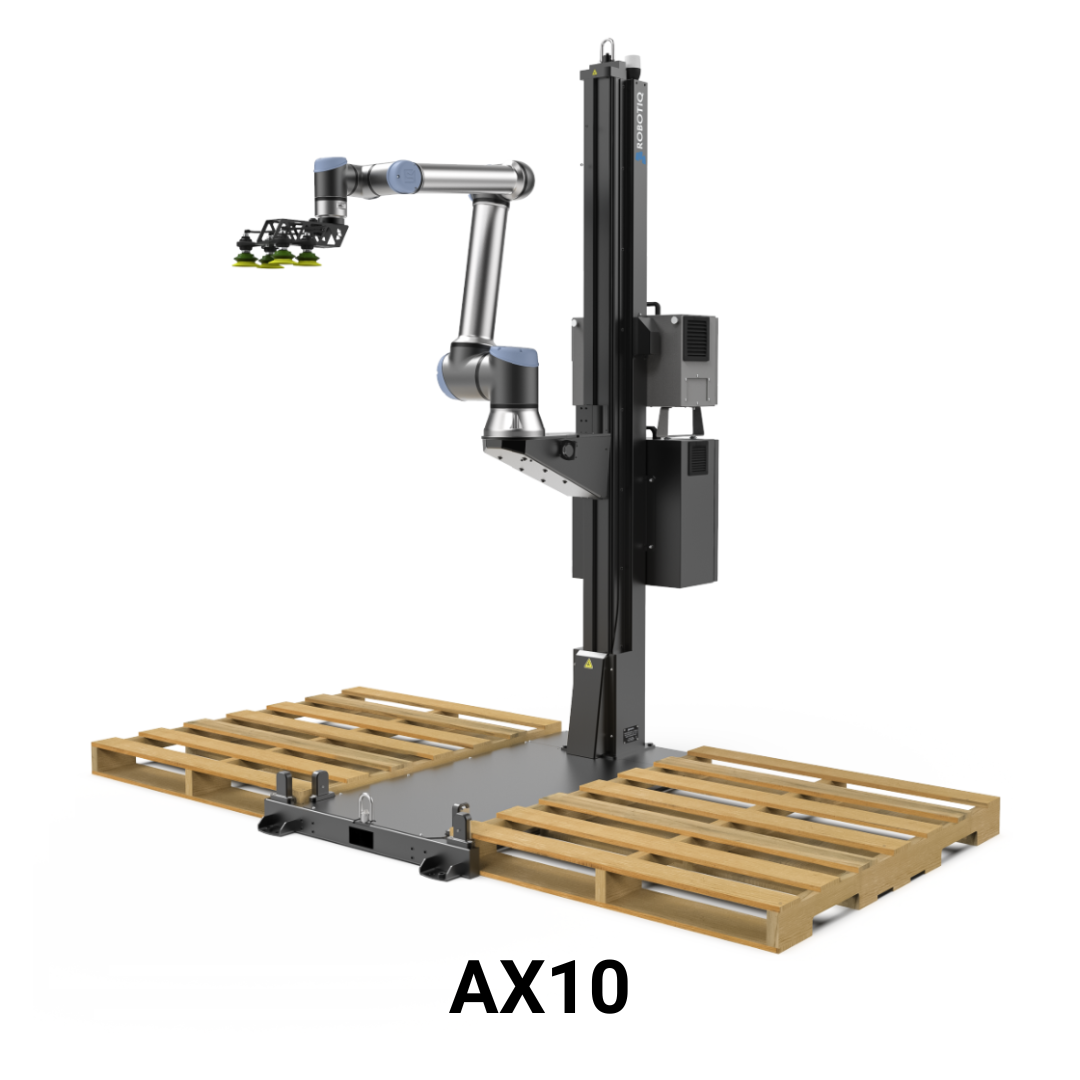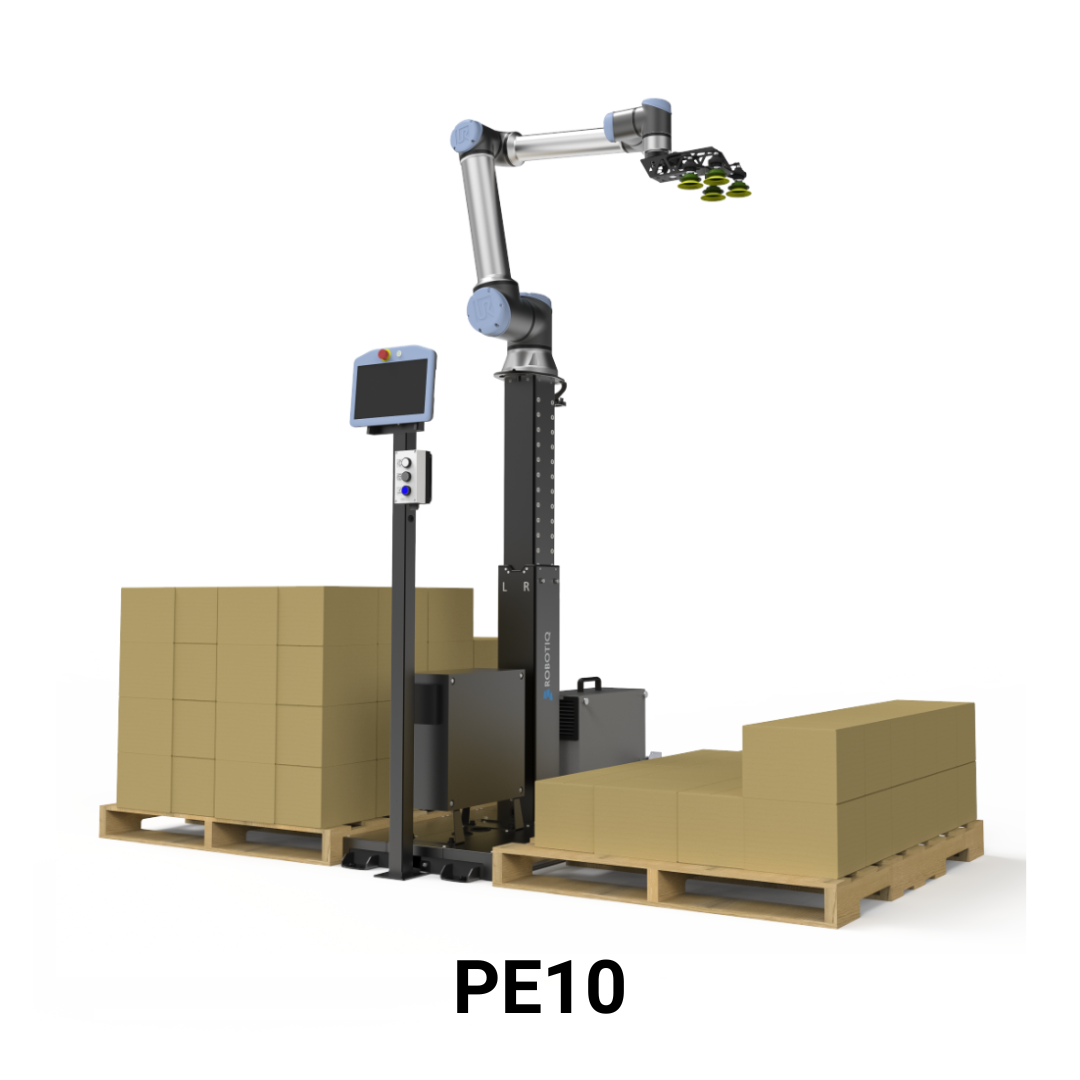Palletizing robot
All about robotic palletizing
___________
Do your business operations require the management of a warehouse? If so, you probably operate (at least) one palletizing station.
Are you having trouble hiring people to do material handling tasks? Among others, those related to palletizing?
Automation is at our doorstep! Thanks to a structuring and profitable investment, it is now possible and even desirable to get rid of labor, safety, productivity and quality problems.
Palletizing - Main Lines
Palletizing is a task that consists of arranging and stacking packages (boxes, bags, buckets, bundles, etc.) on a pallet in order to facilitate their storage or transportation. But in reality, palletizing can also be thought of as a process divided into several subtasks:
-
-
- Distribution and arrangement of pallets (conveyor, pallet truck, forklift, etc.)
-
- Supply of goods to be palletized (conveyor, chute, manual worker, etc.)
-
- Orientation of the goods (dosing belt, rotation device, etc.)
-
- Palletizing (manual or robotized)
-
- Floor formation (centering bars, compression devices, pallet sheet dispensers, etc.)
-
- Security elements (barriers, light curtains, sensors, etc.)
-
- Other third party sub-tasks (banding, strapping, labeling, etc.)
-
-
In the case of automated or semi-automated palletizing, the handling of the goods - from the feeder to the pallet - is done by a robot.
Need help with your palletizing automation project?
Why Automate Palletizing?
The integration of a palletizing solution partially solves some of the issues: addressing labor shortages, ensuring worker safety, and creating stable, high and strong loads.
Automating this process affects the human factor in two ways: it reduces the number and severity of injuries related to handling and lifting goods
Robotic palletizing requires few human resources (and therefore a reduction in expenses closely linked to the return on investment).
Although one might expect an automated palletizing cell to take up a lot of space, the opposite is often true. Once the workspace is configured, the comings and goings are always the same and the physical footprint of the robot is usually very small.
Ultimately, the robot also provides high accuracy, consistent repeatability and increased production capacity.
Characteristics of the cell according to the process to be automated
The design of the palletizing cell depends on a number of material factors, and the compatibility between goods and components.
The speed of the gripper and the robot must be adapted to the the flow of goods into the cell into the cell in order toprevent bottlenecks and damage to equipment or materials.
The payload of the robot and the vacuum gripping force (in the case of air-powered suction end-effectors) must correspond to the mass to be lifted.
The type of material used for packaging the goods must be taken into consideration when choosing the robot's effector tool: porosity, strength, thickness, height, width, format, geometry, irregularities or distinctive features, etc.. This will allow to choose the end effector accordingly - gripper, adaptive hand, vacuum gripper with suction cups, vacuum gripper with foam, etc.
The positioning of packaged goodsThe positioning of the packaged goods, both at the infeed and on the pallet, may require some handling; the reach of the robotic arm and the gripping technique of the end effector are to be checked. This aspect will have an impact on the establishment of a robot trajectory free of singularities and on the ability of the robot to reorient the goods if necessary, and to position them on the pallet in an accurate, stable and safe way.
After having studied the arrangement of the packages on the palletized levels and the formation of the levels on the pallet the size of the packages must of course correspond to the size of the pallet. If the size of the pallet is exceeded, it may become unbalanced or snagged, resulting in damage to the goods. There are different types of pallets (shape, size, material, etc.) depending on the standards in place in certain regions of the world, the type and mass of the materials to be transported, the destination of the load, the storage conditions, and much more.
How to Choose the Right Palletizing Robot?
The choice of robot and cell components depends, among other things, on the objective to be achieved. Increase in production capacity? Improved safety? Smaller footprint? Simplification of product changeovers? Modularity? A little of everything?
The two main decision-making axes are the relationship between industrial and collaborativeand the contrast between custom systems and all-in-one solutions.
Industrial / Traditional Robot

- Large payload
- Few inherent safety features
- Increased complexity - requires a lot of robotics knowledge
- Handling of many types of packaging
- Massive investment
- Large footprint
- Rigidity of the process
- Speed of execution
Collaborative Robot

- Coexistence with workers
- User-friendly and intuitive
- Low payload (relatively) - generally suitable for packages up to 20 kg
- Structuring and profitable investment
- Modular, customizable
- Limitation of the packaging materials that can be handled (given the payload and the choice of effector tools)
Customized system
___________________
- Exact response to the objective to be achieved, but inherent rigidity
- Involvement of many stakeholders for integration
- Total expenses uncertain (given the nice to have and contingencies)
All-in-One Solution
___________________
- WYSIWYG approach, but potential rigidity
- Reduced downtime for commissioning
- Documented operation - facilitates technical support, training and maintenance
- Simplified product changes
How much does a Robot Palletizer cost
Generally speaking, a collaborative robot represents an investment in the range of $40,000 to $70,000, but this is a price range to be taken with a grain of salt.

150,000 to $250,000
the price of the entire cell
In comparison, the integration of industrial robots costs about 10 times more.

40,000 to $70,000
the acquisition of a collaborative robot
The most important point for the buyer is to distinguish between the price of the cobot and the price of the entire robot cell. Depending on the complexity of the project, the retrofit required, the resources deployed in integration and the process to be automated, the total cost can vary between $150,000 and $250,000.

10 TIMES MORE EXPENSIVE
the integration of industrial robots
Need a helping hand to get started?
At Pneumac Automation, we have extensive knowledge of Universal Robots (UR) and Robotiq application solutions, and a strong confidence in the products of both brands.

First of all, UR cobots are the most used in the world, and for good reason! UR makes available to everyone theUR+ ecosystemThe UR+ ecosystem is a pool of robot components and end effectors, which is fed by third party companies. UR puts each manufacturer through a rigorous process of testing, documentation validation, quality control and safety certification before including them in the UR+ ecosystem.
For this reason, we recommend the integration of robots with long reach and high payload, suitable for palletizing contexts: the UR10e (1300 mm, 12.5 kg) and the UR20 (1750 mm, 20 kg).
Collaborative Robot UR10e
Universal Robots

The UR10e is an extraordinarily versatile collaborative robot, offering both a high load capacity (12.5 kg) and a long reach (1300 mm).
UR20 Collaborative Robot
Universal Robots

With a reach of 1750 mm and a payload capacity of 20 kg, the new generation UR cobot handles more tasks and adapts to more applications.

Secondly, the hardware components and application solutions from Robotiq are incredibly adaptable and can meet most requirements with a modest and sustainable investment.
Robotiq has introduced the AX Series Palletizer, mounted on a vertical axis controlled by software, and the PE Series Palletizer, mounted on a column whose height can be adjusted manually.
We also recommend these all-in-one systems because of their ease of integration, intuitive software and small footprint.
Robotiq Palletizing Solution
AX Series

Ideal for handling a a wide variety of pallet heights and light loads.
Robotiq Palletizing Solution
PE Series

Ideal for light loads and small pallets.
Robotiq Palletizing Solution
PE Series

Ideal for heavier loads and moderate pallet heights.
Would you like to know more?
Address
100 Goyer Street, room 103
La Prairie (QC)
J5R 5G5
Phone
514.745.1987
1.800.361.1684
info@pneumac.qc.ca


